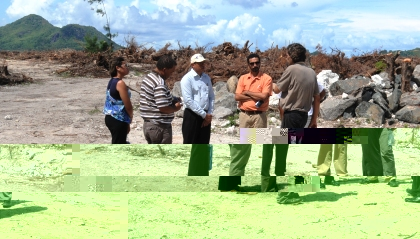‘Romainville site ready for wind turbines’ |13 April 2012

Minister Payet and his delegation visiting the Romainville island which has been cleared to receive the embeds
This will be in a project funded by the United Arab Emirates (UAE) and expected to cut Seychelles’ hydrocarbon fuel-generated electricity by 11%.
The minister was told the site is ready for the turbines.
He was accompanied by his principal secretary Wills Agricole, the chief executive of the energy commission Andrew Jean-Louis and the deputy chief executive of the Public Utilities Company (PUC) Joel Valmont.
They and members of the media travelled to Romainville from Eden Island.
Romainville is the only one of the reclaimed islands not linked to the mainland and it was a 10-minute crossing by speedboat.
The group was shown around by Grant Heyer – who with Conrad Mondon – are the engineers for the Korean manufacturing firm, Unison, involved in the project.
The US $22 million project is a gift from the UAE Government for which Abu Dhabi based Masdar are the implementation contractors.
Dr Payet said he was happy that the site for the five turbines on Romainville – the three other turbines will be sited on Ile du Port – is ready, all the casuarina trees having been felled and the logs used in a piling beach rehabilitation project which Dr Payet inspected on Thursday last week at Anse à La Mouche.
He said it remains for the concrete bases to be built, and construction will have to be done at one go, to ensure they are strong enough, before the various components of the turbines are mounted.
Dr Payet said he expects mounting the wind turbines to be under way in August and the first ones tested in November.
Once they are all ready, they will be linked to the PUC power station.
He noted that with the rise in fuel prices – by 35% since December, it has clearly become imperative that we switch to alternative energy sources. He noted the eight wind turbines – each generating 700 kilowatts of electricity – will reduce our fuel consumption by 11% for our national electricity needs.
Dr Payet also noted that besides the wind turbines, Romainville will also be used to site some photovoltaic cells, in another effort to reduce our increasingly heavy fuel bill.
Responding to a question about possible noise pollution, he said this will be kept to a minimum, adding the technology used here will be the latest state-of-the-art.
“We are also having only eight turbines, compared to countries which erect up to 2,000,” he said.
Dr Payet said that the turbines on the two islands will be visible and show visitors we care about the environment, and switching to alternatives energy sources constitutes part of such efforts.
From Romainville, the party stopped at the commercial port to inspect eight 4.2-metre diameters embeds, which are the first components of the wind turbines to be shipped here.
These, Mr Heyer said, will be partly embedded in the concrete base. He said they will have to be moved at night on large trailers to the reclamation areas.
The turbines, he said will be 70 metres to 100 metres high, depending on where they are. Those nearer to aircraft flight path will be shorter than those farther away.
Each turbine will have three 24-metre long blades, all together giving a total diameter of over 50 metres as they move with the wind velocity, which means they will have to be sited well apart from each other.
The visitors were told that other components will be arriving shortly and be offloaded by 30-tonne cranes, one of which is presently being used on the Praslin reclamation project.
Once construction of the turbines proper starts, the project will need over 300 workers from Mahe Builders, the sole local contractor involved.





